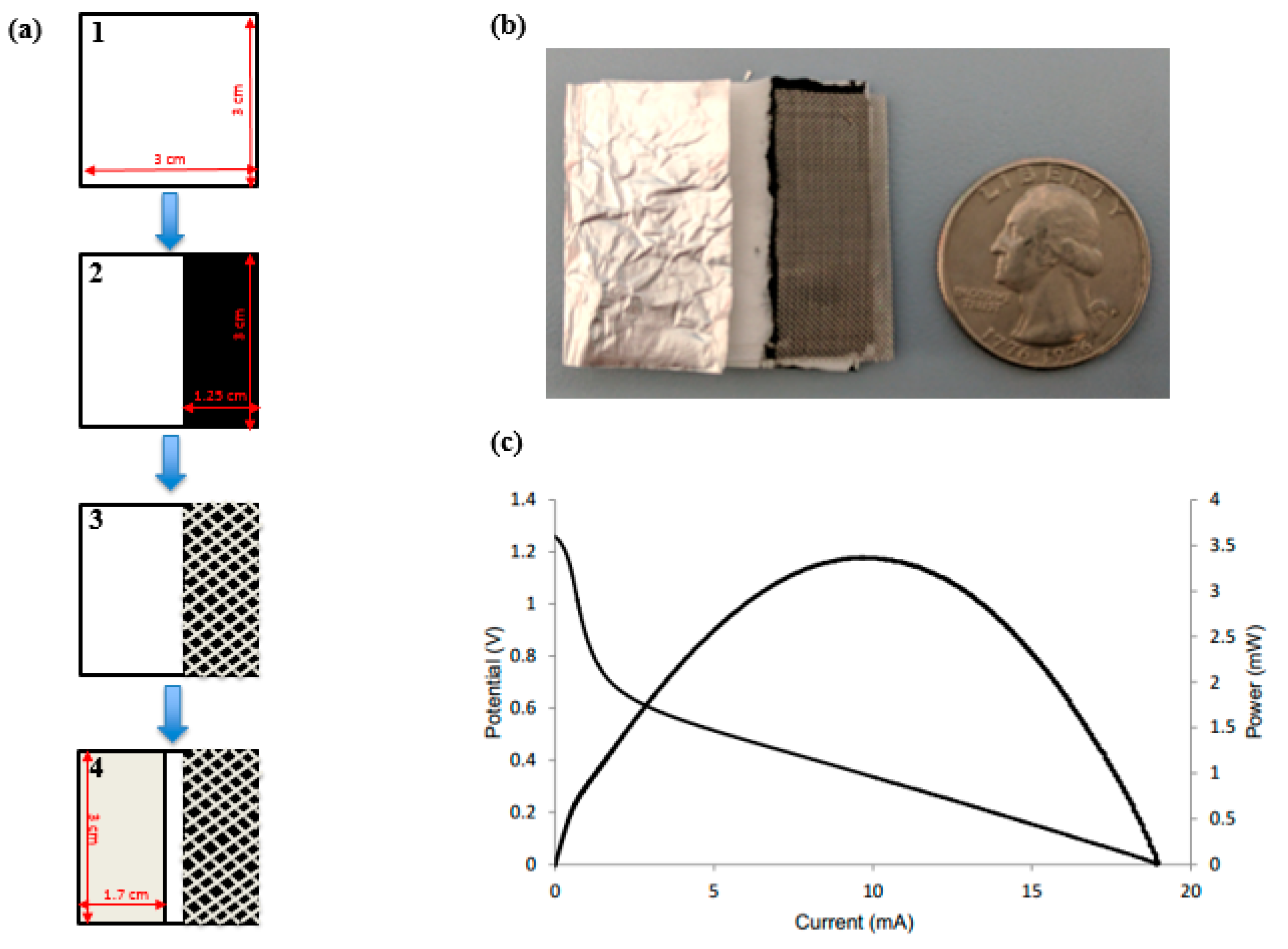Alternative sources of power have become essential due to increasing global energy demand. Human-induced climate change drives the search for alternative and renewable energy sources, including solar energy, fuel cells (FCs), supercapacitors, and novel material batteries. Batteries are used in applications such as automobiles, cellular devices, computers, and other portable electronic devices, and are thus important energy sources to improve upon [
1]. Aluminum was first introduced as a viable electrode for batteries in the 1850s by Hulot, when it was used as a cathode material in a zinc battery [
2]. Several years later, aluminum was first used as the anode material in the Buff cell [
3]. In the 1960s, Zaromb and Trevethan et al. introduced an aluminum/oxygen battery system; however, because of the formation of a non-reactive oxide layer on the aluminum under these conditions, the development of these types of batteries was not initially successful [
4,
5]. Thus, extensive efforts were made to develop a method of overcoming the formation of this oxide layer. One of the most effective methods was the use of aluminum alloys and doping the electrolyte with other compounds [
6,
7,
8]. Among the metal/air batteries, aluminum/air batteries have a remarkable energy density (8.1 kW/kg) and a theoretical voltage of 2.71 V [
9]. The low cost and ubiquitous nature of aluminum also makes it appealing for use as an anode for a variety of devices.
Traditional microfluidic devices (MDs) are composed of various polymers, most notably poly(dimethylsiloxane) (PDMS), which require external pumps to maintain fluid flow. Other substrates have been explored in an effort to reduce the cost of MDs, with one of the most prevalent being paper. Recently, paper material has been integrated into electrochemical devices due to its advantages over other platforms. Paper is ubiquitous, universally available, and an inexpensive alternative to other materials including glass and silicon [
10]. Also, cellulose fibers make up the majority of various types of paper and allow the passive flow of fluids through capillary action, which consequently removes the need for external pumps [
11]. Paper-like energy storage devices are becoming more attractive due to their easy integration with electronic devices [
12]. Moreover, paper’s porosity makes it beneficial for the manipulation of electrons and ion transport throughout the structure [
13]. Different types of paper can be used to manipulate flow rates and pore sizes depending on the desired output. There have been a myriad of paper electronic devices to date, which include electrochemical batteries, FCs, lithium-ion batteries, supercapacitors, and nanogenerators [
10]. Despite these devices being more simplistic than conventional electronic devices, many still require complex fabrication. Paper has its disadvantages as well, which include its fragility. Paper may be subject to folding and tearing and is vulnerable in environmental settings unless encased in a protective layer. The first paper-based aluminum battery was demonstrated by Ferreria et al. using a layering structure of aluminum/paper/copper through thermal evaporation of the metal layers [
14]. Using this structure, a current of 150 nA–0.5 mA was achieved. In this paper, different electrode materials and platform design were used, resulting in significantly less amperage and voltage compared to the current work. In 2013, Thom et al. as well as Zhang et al., showed improvement in the performance and feasibility of fabrication of a paper-based aluminum battery producing 1.3 V and 2.2 mA, and 1.53 V and 4.4 m/cm
2, respectively [
15,
16]. In the work of Zhang, the batteries were used to power a glucose assay, demonstrating the potential application of this technology. These include providing sustainable power for point-of-care (POC) diagnostic devices, and other one-time use devices that currently employ button-cell batteries. There is a need to develop alternative power sources to button cell batteries, because they often times contain more energy than required and are environmentally hazardous when disposed of. The materials used in this aluminum-air battery can be reused either in the battery itself or in industrial processes. For example, steel mesh, activated carbon, and Kim Wipes, which are components of our aluminum-air battery, can be reused in the same battery after adding potassium hydroxide (KOH). The product of the anode reaction, aluminum hydroxide, Al(OH)
3, is also a principal component of bauxite, which is used to manufacture alumina in the Bayer process. The resulting alumina is then used for the production of aluminum metal [
17]. In this manuscript, we demonstrate a facile, cost-effective, and recyclable method of fabricating a paper-based aluminum-air flow battery with four fabrication steps, while generating power that is on par with other paper-based aluminum-air batteries (1.27 V and 3.4 mA/cm
2) [
15,
16]. In addition, we also report on the optimization of the composition of the device, such as the cathodic material, the dimensions of the platform and electrodes, and the potential use in small applications. There was no specific algorithm used in the optimization; however, given that the voltage was relatively constant, optimization was mostly focused on maximizing the current as well as having a low relative standard deviation (RSD) of the amperage. When connecting the devices in series to ultimately power small devices, it was important to have not only high power, but also have high reproducibility in order for the devices to avoid being significantly affected by the weakest link.








